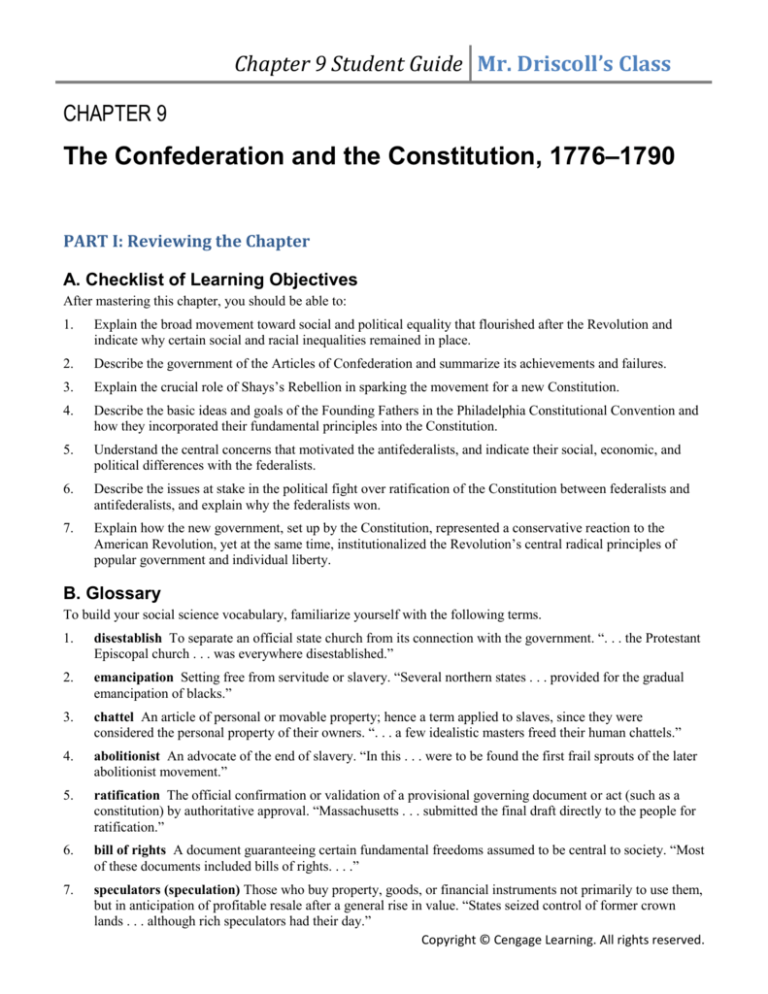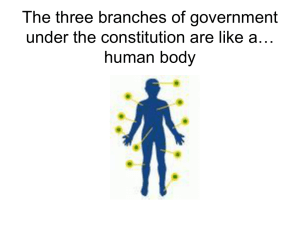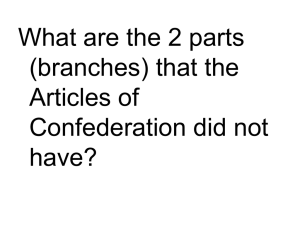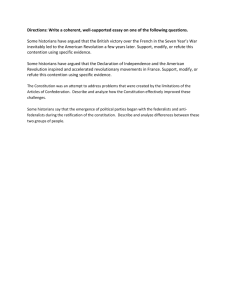
Chapter 9 Student Guide Mr. Driscoll’s Class
CHAPTER 9
The Confederation and the Constitution, 1776–1790
PART I: Reviewing the Chapter
A. Checklist of Learning Objectives
After mastering this chapter, you should be able to:
1.
Explain the broad movement toward social and political equality that flourished after the Revolution and
indicate why certain social and racial inequalities remained in place.
2.
Describe the government of the Articles of Confederation and summarize its achievements and failures.
3.
Explain the crucial role of Shays’s Rebellion in sparking the movement for a new Constitution.
4.
Describe the basic ideas and goals of the Founding Fathers in the Philadelphia Constitutional Convention and
how they incorporated their fundamental principles into the Constitution.
5.
Understand the central concerns that motivated the antifederalists, and indicate their social, economic, and
political differences with the federalists.
6.
Describe the issues at stake in the political fight over ratification of the Constitution between federalists and
antifederalists, and explain why the federalists won.
7.
Explain how the new government, set up by the Constitution, represented a conservative reaction to the
American Revolution, yet at the same time, institutionalized the Revolution’s central radical principles of
popular government and individual liberty.
B. Glossary
To build your social science vocabulary, familiarize yourself with the following terms.
1.
disestablish To separate an official state church from its connection with the government. “. . . the Protestant
Episcopal church . . . was everywhere disestablished.”
2.
emancipation Setting free from servitude or slavery. “Several northern states . . . provided for the gradual
emancipation of blacks.”
3.
chattel An article of personal or movable property; hence a term applied to slaves, since they were
considered the personal property of their owners. “. . . a few idealistic masters freed their human chattels.”
4.
abolitionist An advocate of the end of slavery. “In this . . . were to be found the first frail sprouts of the later
abolitionist movement.”
5.
ratification The official confirmation or validation of a provisional governing document or act (such as a
constitution) by authoritative approval. “Massachusetts . . . submitted the final draft directly to the people for
ratification.”
6.
bill of rights A document guaranteeing certain fundamental freedoms assumed to be central to society. “Most
of these documents included bills of rights. . . .”
7.
speculators (speculation) Those who buy property, goods, or financial instruments not primarily to use them,
but in anticipation of profitable resale after a general rise in value. “States seized control of former crown
lands . . . although rich speculators had their day.”
Copyright © Cengage Learning. All rights reserved.
Chapter 9 Student Guide Mr. Driscoll’s Class
8.
township In America, a surveyed territory six miles square; the term also refers to a unit of local government,
smaller than a county, that is often based on these survey units. “The sixteenth section of each township was
set aside to be sold for the benefit of the public schools. . . .”
9.
territory In American government, an organized political entity not yet enjoying the full and equal status of a
state. “. . . when a territory could boast sixty thousand inhabitants, it might be admitted by Congress as a
state. . . .”
10. annex To incorporate a smaller territory or political unit into a larger one. “They . . . sought to annex that
rebellious area to Britain.”
11. requisition A demand for something issued on the basis of public authority. “The requisition system of
raising money was breaking down. . . .”
12. foreclosure Seizing private, mortgaged property from the owner because the legal payments on the loan have
not been kept up. “. . . Revolutionary war veterans were losing their farms through mortgage foreclosures.”
13. quorum The minimum number of persons who must be present in a group before it can conduct valid
business. “A quorum of the fifty-five emissaries from twelve states finally convened at Philadelphia. . . .”
14. anarchy The theory that formal government is unnecessary and wrong in principle; the term is also used
generally for lawlessness or antigovernmental disorder. “Delegates were determined to preserve the union
[and] forestall anarchy. . . .”
15. bicameral, unicameral Referring to a legislative body with two houses (bicameral) or one (unicameral).
“. . . representation in both houses of a bicameral Congress should be based on population. . . .” “This
provided for equal representation in a unicameral Congress. . . .”
AP Focus
As a consequence of the American Revolution, Americans begin to rethink their views regarding the
separation of church and state, as well as the future of slavery in a democratic republic.
The American economy is profoundly affected by the war. Along with the consequences of British
mercantilist policies on the development of the American economy, the absence of a governmental structure
that could address the nation’s economic and judicial requirements aggravates the situation.
The first government, the Articles of Confederation, fails to deal adequately with the problems facing the new
nation. Social tensions stimulate the demand for a stronger central government, one with the power and
authority to suppress domestic disturbances, such as Shays’s Rebellion.
The antecedents of the United States Constitution can be found in the political ideas, theories, and concepts
associated with the state constitutions. Politics and Citizenship is an AP theme.
The U.S. Constitution is ratified and replaces the Articles of Confederation, but not before advocates and
opponents of a strong central government do political battle on the state level.
Take note of the following:
1.
Despite the inadequacies of the Articles of Confederation, the government did address a significant problem
associated with disputed land claims by passing the Northwest Ordinance. The government was unable,
however, to prevent British and Spanish encroachments and influences in the west. See the map in The
American Pageant (13th ed., p. 175/14th ed., p. 184) for the locations of disputed territory and continued
foreign influences.
2.
Because of opposition from antifederalists, the Constitution extended certain delegated powers to the federal
government, while reserving important powers to the states. Further, a Bill of Rights was later added.
Copyright © Cengage Learning. All rights reserved.
Chapter 9 Student Guide Mr. Driscoll’s Class
Chapter Themes
Theme: The American Revolution was not a radical transformation like the French or Russian revolutions, but it
did produce political innovations and some social change in the direction of greater equality and democracy.
Theme: Compromise, on a number of important issues, was required in order to create the new federal
Constitution. Adopting the new document required great political skill and involved changing the ratification
process defined in the Articles of Confederation, writing persuasively in support of the stronger central government,
and promising to add amendments to protect individual liberty and states’ rights.
Theme: The federal Constitution represented a moderately conservative reaction against the democratic and
decentralizing effects of the Revolution and the Articles of Confederation. In effect, it embedded the revolutionary
ideals of liberty and popular government within a strong framework designed to advance national identity and
interests against the dangers of fragmentation and disorder.
CHAPTER SUMMARY
The American Revolution did not overturn the social order, but it did produce substantial changes in social
customs, political institutions, and ideas about society and government. Among the changes were the separation of
church and state in some places, the abolition of slavery in the North, written political constitutions, and a shift in
political power from the eastern seaboard toward the frontier.
The first weak national government, the Articles of Confederation, was unable to exercise real authority, although it
did successfully deal with the western lands issue. The Confederation’s weaknesses in handling foreign policy,
commerce, and the Shays rebellion spurred the movement to alter the Articles.
Instead of revising the Articles, the well-off delegates to the Constitutional Convention created a permanent charter
for a whole new government. In a series of compromises, the convention produced a plan that provided for a
vigorous central government, a strong executive, and protection for property, while still upholding republican
principles and states’ rights. The pro-Constitution Federalists, generally representing wealthier and more
commercial forces, frightened other groups who feared that the new government would undermine their rights and
their interests.
The Federalists met their strongest opposition from Anti-Federalists in Virginia and New York, but through
effective organization and argument, as well as promises to incorporate a bill of rights into the document, they
succeeded in getting the Constitution ratified. By establishing the new national government, the Federalists checked
the Revolutionary movement, but their conservative regime embraced the central Revolutionary values of popular
republican government and liberty.
Character Sketches
Daniel Shays (1747–1825)
Shays was the Massachusetts Revolutionary War veteran whose rebellion, in 1786, spurred the movement for a new
Constitution.
A militiaman at Lexington and Bunker Hill, Shays was typical of the ordinary Revolutionary-era Americans who
left their farms to fight in the War for Independence. He rose to captain, and after the war, he was elected to various
local offices.
Shays emerged as the leader of the revolt by indebted farmers when eight hundred armed men prevented a
Springfield court from hearing foreclosure cases. He continually insisted that the farmers wanted only redress of
grievances, not violence, but by early 1787, he was preparing to attack a state arsenal. The attack failed, and Shays
fled to Vermont. He was condemned to death but pardoned the next year, and eventually, he returned to
Massachusetts to live out his days in peace.
Copyright © Cengage Learning. All rights reserved.
Chapter 9 Student Guide Mr. Driscoll’s Class
Quote: “The people assembled in arms…return for answer that, however unjustifiable the measure may be which
the people have adopted in recourse to arms, various circumstances have induced them thereto.…That virtue which
truly characterizes the citizens of a republican government hath hitherto marked our plans with a degree of
innocence, and we wish and trust it will still be the case.” (Reply to General Benjamin Lincoln’s demand for
surrender, 1787)
REFERENCE: David Szatmoy, Shays’s Rebellion (1980).
James Madison (1750–1836)
Madison, the “Father of the Constitution,” is generally considered the most original political thinker among the
Founding Fathers. The only failure during his long career of public service was his term as president, which
included the near-disastrous War of 1812.
Madison attended Princeton and considered entering the ministry. He strongly disliked religious intolerance and his
first political activities were on behalf of religious disestablishment in Virginia.
Throughout his life he kept extensive journals, and his notes on the proceedings of the secret Constitutional
Convention provide the only detailed record of the arguments there.
Madison’s marriage to Dolley Payne Todd was a long and happy one. Since Jefferson was a widower, the
Madisons’ home was the social center of Washington during both the Jefferson and the Madison administrations.
Although quiet, bookish, and introspective, Madison was personally warm and engaging, especially in intimate
settings.
Quote: “Hearken not to the unnatural voice which tells you that the people of America, knit together as they are by
so many cords of affection, can no longer…be fellow-citizens of one great, respectable, and flourishing empire,
Hearken not to the voice which petulantly tells you that the form of government recommended for your adoption is
a novelty in the political world.… If novelties are to be shunned, believe me, the most alarming of all novelties, the
most wild of all projects, the most rash of all attempts, is that of rending us in pieces, in order to preserve our
liberties and promote our happiness.” (Federalist No. 14, 1788)
REFERENCE: Irving Brant, The Fourth President: A Life of James Madison (1970).
Patrick Henry (1736–1799)
Henry was the famous Revolutionary orator and five-term Virginia governor who later became the leading AntiFederalist opponent of the Constitution.
He came from a plain frontier background rather than from the planter aristocracy. When his uncle took him to hear
Samuel Davies, a famous Great Awakening preacher, young Patrick fell in love with the art of persuasive speaking.
Henry’s eloquent defenses of Virginia liberty, at the time of the Stamp Act, made him the youthful leader of the
radical party in that state. He made his “give me liberty or give me death!” speech during the debate over whether
the Virginia assembly should take steps toward independence.
Henry’s young protégé, Thomas Jefferson, succeeded him as governor during the Revolution, but Henry later
demanded an investigation of Jefferson’s conduct in office, which caused a bitter and lasting feud between the two.
In his later years Henry was plagued with financial troubles and became increasingly conservative.
Quote: “It is now confessed that this is a national government.… The means, says the gentleman, must be
commensurate to the end. How does this apply? All things in common are left with this government. There being an
infinitude in the government, there must be an infinitude of means to carry it out.” (Virginia debate on the
Constitution, 1788)
REFERENCE: Richard R. Beeman, Patrick Henry (1974).
Copyright © Cengage Learning. All rights reserved.








